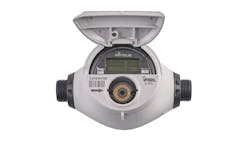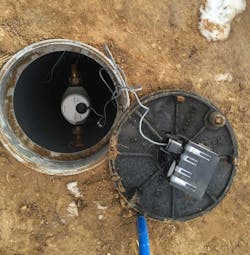Smart water metering is one of the most iconic forms of digitalization available to water utilities today.
Smart meters offer unique and powerful benefits for drinking water management, making it possible to automate shutoffs and expand data collection for a relatively low cost.
In a time where revenue and water scarcity are growing concerns for water utilities, smart meters are a critical tool for sustainability and financial stability.
But how do they work, what benefits do they bring to utilities and what are their downsides?
Smart water meters, broadly
Water meters are a critical part of water utility operations.
“If you think about a water utility, everything from water capture through distribution all the way to your tap is capital intensive and cost intensive — and the only place that a utility recovers any of that cost is with a water reader. It is the only thing in the system that generates revenue for them,” said Trey Overman, senior director of global water product management for Xylem. “A water meter’s basic function is to register usage in some sort of quantitative term that gets turned into a bill. And so that's its basic function. But what we've seen and what we've been able to develop technologically is getting significantly more, richer insights based on basic consumption measurements.”
Where traditional water meters would need staff to manually read the meters periodically, smart water meters can automatically transmit its collected data through communication networks.
“If you think about a very basic water meter from 100 years ago, it's heavy, it’s brass, it's got a mechanical dial,” said Overman. “Somebody looks at it once a month, comes in the next month or some period of time, sees what the measurement is. The guy does the delta from the prior one, calculates water use, and sends a bill. Smart meters go way beyond that.”
A smart water meter measures and monitors water flow with the aid of modern data management solutions. They have enhanced sensors, data storage, and communications capabilities that make data collection easier and the data itself richer.
The difference between AMR, AMI and smart water meters
Two acronyms that are adjacent to smart water meters are AMR and AMI. What are these acronyms, and how do they relate to smart water meters?
Generally, smart water meters are one step of complexity beyond automated meter reading (AMR). Where AMR only needs to transmit information, smart water meters use two-way communication to both transmit and receive information.
One key application of this difference is that smart water meters can receive shutoff instructions from the utility, adding another efficiency to financial operations.
When someone says that smart water meters can receive automated shutoff instructions, it assumes many things besides the meter itself: a physical communications network, a data center to coordinate communications and store information, a software platform that manages data to send the automated shutoff instructions, and much more.
Smart water meters are typically part of a sophisticated system of meters, web-based interfaces and communication networks. The broad term for this group of underlying solutions can be referred to as advanced metering infrastructure (AMI).
AMI is the overall system that smart water meters use to communicate, as well as to manage and analyze data.
How smart water meters work
Smart water meters measure flow characteristics with static sensors in a compact, rugged housing. Because the sensors are static, they are less prone to the wear and accuracy loss that afflict mechanical meters.
The dominant types of sensors within smart water meters are ultrasonic, electromagnetic, or vortex flow. Some meters use only one type of sensor, while others employ a hybrid of different types for more versatile measurements.
With these sensors, smart meters can collect several different data points, including flow rates, timestamps, cumulative usage, pressure and temperature. This data is regularly transmitted to a centralized data platform, where it can be managed and analyzed.
Smart water meters are generally not connected to the internet by a physical wire, relying instead on wireless communication. The wireless communication technologies for AMI come down to different expressions of radio communication — from a radio frequency mesh to cellular networks or low-power, wide area protocols like LoRaWAN.
The variety of data points available to smart water meters make them useful for much more than enhanced billing.
“But beyond just being able to measure, you can make alarms around it,” said Overman. “So in our flagship product, we have continuous flow alarms, high flow alarms, low flow alarms, backflow alarms. As you're measuring the water, it can generate data to a utility that's actionable beyond just basic billing.”
The centralized data platform can also generate reports on water consumption patterns across a distribution network, identify possible leaks, create bills and provide consumers with their own consumption data.
The benefits of smart water meters
Smart water meters provide a wealth of strong benefits. They allow for enhanced data, precise billing, automated operations, efficient resource management and more.
“Being able to get more timely data, more accurate data, more actionable data benefits the utilities in (I would argue) an innumerable number of ways,” said Overman. “But certainly with better matching generation to usage rate, reducing that non-revenue water, getting it down so it's more energy efficient, having more accurate bills for customers and having more accurate insights for customers.”
One of the most valuable benefits from smart water meters is the data. They offer more regular measurements with greater precision and more parameters. When it comes to large-scale operations in the information age, data always finds a way to help optimize.
“It’s pushing more information back to the utility that helps them optimize and more efficiently run their own operations and, frankly, helps them both save money and generate money,” said Overman.
The data can be useful in both short-term and long-term operations. In the short term, it can help to detect leaks in real-time, allowing for rapid emergency responses. In the long term, it can also help the utility to better anticipate water consumption trends over the course of a given day, week or year.
Smart meters’ two-way communication allows for automated operations, thus reducing meters’ labor needs. Manual meter readings are no longer required, and personnel aren’t needed to shut off or resume service to any customers’ houses. Water utilities can employ these saved personnel resources for other vital operations.
AMI can provide customer portals with the data generated by smart water meters. There, consumers can see their real-time water usage and set automated alerts. This real-time consumption feedback can help to promote customers’ water conservation.
“It's also a great benefit for the end customer because most customers typically find that they have a leak or some sort of other catastrophic event when they get a water bill next month that's exponentially more expensive than it was the month before,” said Overman.
The challenges of smart water meters
Smart water management is not an effortless achievement, and there are concrete reasons why smart water meter adoption may not be viable.
Smart water meters are a sophisticated solution. As such, they also require a sophisticated environment — advanced metering infrastructure — to work properly, which can be expensive to develop.
The meter installation itself, communication infrastructure, data management platforms and training can all present increased costs for a utility’s smart water management. The complexity and versatility of AMI can require a significant time investment for personnel to become familiar with the solution.
The significance of these challenges will depend on the utility’s tolerance for new costs and sophistication. More often than not, however, the long-term benefits of smart water meters will outweigh the costs.
About the Author
Jeremy Wolfe
Jeremy Wolfe is a former Editor for WaterWorld magazine.


